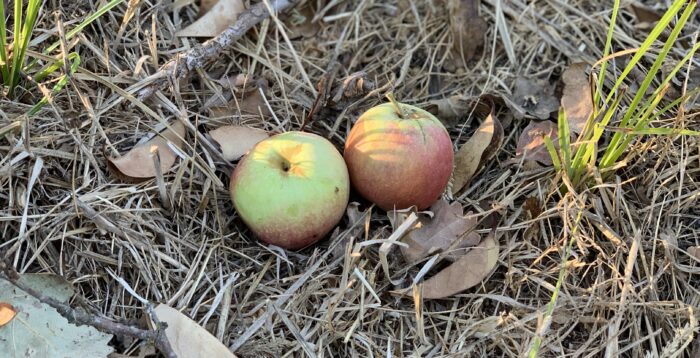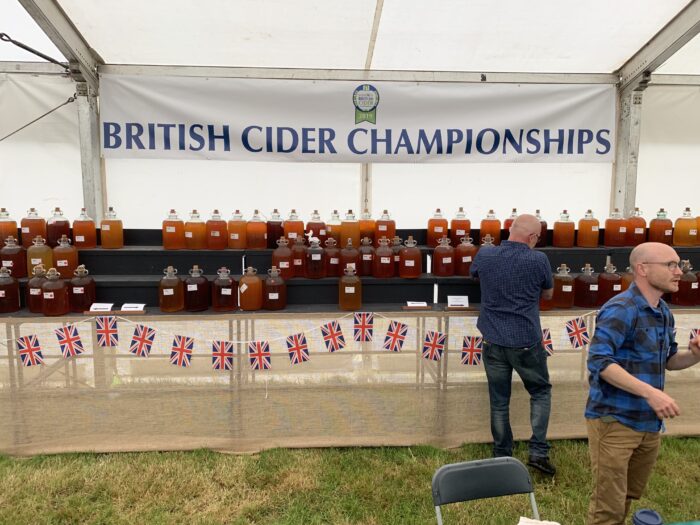
William Dabinett was born in 1861, the 69th soul in the small Somerset village of Middle Lambrook. His father, also William, was a farm laborer and his mother, Sarah, a glover–working class families needed to earn every penny they could to make ends meet. By the age of ten William the younger had left school and was working in the fields, too. Farm work is hard, physical, thirsty work, and laborers were often paid part of their wages in cider until amendments made to the Truck Act in 1877 forbade the practice. No doubt it took a while for employers to take the new law seriously, though, and testimony in parliament made clear that they could still give their workers food and drink as long as it wasn’t in lieu of coin.
Local lore says that one of the Williams discovered the eponymous tree growing in a hedgerow, a wilding or gribble in the dialect of Somerset. The tale does not, however, include when the discovery was made or what was done with the information afterwards. I like think that William was working for one of the cidermaking farmers in nearby Kingsbury Episcopi, perhaps Charles Porter or Richard Scott, and that William brought the apple to him. That might explain how the Dabinett name became attached to it, at any rate.
While census records indicate that William the elder was a farm worker until the day he died in 1865, his son managed to improve his lot. He had found employment as a gardener by the 1890s, and a decade later had started what turned out to be a pretty successful poultry-breeding business, leaving an estate of £2,126 (just under $100,000 in 2020 dollars)by the the time he died in 1918. There is no indication that either of the William Dabinetts had any more connection to either apples or cider beyond that fortuitous discovery.
Dabinett the apple first enters the written record in the 1896 Journal of the Bath and West Society appearing in a table with analyses of local cider apples made by chemist Fredrick Lloyd, who’d been hired several years previously as part of the efforts to improve local cider. The apples been harvested in 1895 from the farm of the aforementioned Mr. Scott and had a specific gravity of 1.0655, 1.6 g/L of malic acid, and 2.7 g/L of tannin, making it a mild bittersweet according to the parameters that would be set later by the National Fruit and Cider Institute. (Also included was the already famous Kingston Black with an SG of 1.0672, 6.4 g/L acid, and 1.1 g/L tannin.)
In addition to funding Mr. Lloyd’s research work testing rootstocks, analyzing apple juice, and conducting experiments on the best practices for cidermaking, the Bath and West Society had also recently made the decision to add an exhibition of cider to their annual meeting. Exhibitions of this kind were intended to promote advancement by awarding prizes to the best examples of agricultural products important to the area. The Society had been rewarding producers of the best cheddar cheese, horses, dairy cows, pigs, and other farm products for decades, and cider certainly fit with their improvingmission.
The first cider exhibition took place in 1895, then again in 1896 with slightly modified rules. Entries were classified by one of four regions (Devonshire, Herefordshire, Somerset, and anywhere outside of these counties), then sub-classified into cider made by, or for, 1. landowners that owned and occupied at least 50 acres of land, five of which had to be orchard, 2. tenant farmers occupying at least 30 acres, three at least in orchard, and 3. cider merchants whose business was making and selling cider. The final division was into two classes: cider in cask and cider in bottles. An interesting approach to say the least. The cider had to have been made in the year prior to the exhibition, made only with apple juice, and be a minimum of 4% alcohol by volume. Judges were instructed to consider “(1) Flavour; (2) Aroma; (3) Clearness; [and] (4) Alcoholic strength.”

In 1897, entrants were asked to include information about the varieties used, conditions in the orchard, and whether or not they used fertilizer, as the organizers thought this would add to the knowledge base for determining what made a good cider. Richard Scott included Dabinett in two prize-winning ciders that year (equal parts Chisel Jersey, Dabinett, and Kingston Black plus a handful of Cap of Liberty), and shared that he ran pigs under the trees. Norfolk cider merchant R. Rout & Son won both 1st and 2nd prizes in their regional division that same year with ciders made of russets and London Pippin and Blenheim Orange and Water Pippin, respectively. “These varieties would be considered, as a rule, rather table than cider fruit,” wrote competition steward F.G. Farwell when reporting on the exhibition for the 1898 Journal. “They made, however, a most excellent beverage. . . more like champagne than cider. . . It is clear that there is yet ample scope for further investigations as to the varieties of apples which can be used for cider-making,” he continued, demonstrating once again that quality and deliciousness is not synonymous with tannin.
The point about alcoholic strength is an interesting one. Each entry was analyzed by Mr. Lloyd to make certain that it was up to the grade. Just over 60% of the 1895 entries were disqualified as having insufficient alcohol (31 out of 51); 14 of 44 in 1896, and 16 of 44 the following year. This state of affairs was apparently a source of frustration to the organizers. “It is evident that cider makers as a class have not yet been convinced, and that they consider the 4 per cent [sic] standard too arbitrary,” Mr. Farwell wrote, also in 1898. “I submit with every confidence that the 4 per cent standard is absolutely necessary if cider is to have keeping qualities without the use of preservatives, and that any matter in the shape of preservatives is not only deleterious to the cider, but in many cases prejudicial to the health of consumers.” Keeping in mind that the sorts of preservatives being tested in cider at this time were formaldehyde and salicylic acid (aspirin), one can understand why both flavor and health might be compromised. Nevertheless, the Society changed the rules for the following year to allow a separate subclass for ciders under 4% alcohol.
Dabinett appears on and off in the Bath and West reports over the next five or so years, though only from farms within five miles of Middle Lambrook suggesting that it remained very much a local variety. But people like Mr. Lloyd and the scientists at the National Fruit and Cider Institute, established in 1903, liked Dabinett very much. They grew it their research orchard, used it to test various orchard practices such as top-working existing trees, analyzed fresh juice, and continued to make test batches of cider (they thought it was best in a blend). Director B.T.P. Barker and Superintendent of the Fruit Department John Ettle published a summary of the Institute’s work in 1911, including Dabinett in their short list of high quality cider fruit as well as on a list of “profitable sorts to grow” thus encouraging Dabinett’s spread out of its home region. Though grown around the world today, it doesn’t do well in every climate. It grows best in places that give it a significant number of chill hours, time spent below 30˚ F during its winter dormant period. Without sufficient chill hours it tends to leaf out months behind its peers in the orchard, bloom at often inappropriate times, and grow hardly at all.
Long thought to be a seedling of another bittersweet apple, Chisel Jersey, recent DNA analysis has shown this to be not the case. More likely parents are Burrow Hill Early and Hereford Broadleaf. Whichever its parents are, though, it does in fact make a very fine cider, though the examples we tried suggest that the folks at the National Fruit and Cider Institute were right about it being best in a blend, for adding some percentage of juice from a sharp variety like Foxwhelp gave the smoky, leathery flavors of Dabinett a little more brightness. Many were matured in oak, which may account for some of the smokiness. Stone fruit flavors, apricot in particular, were another common note, along with mandarin orange. How I wish I could grow it, but, alas, my orchard site is just a little too warm.
Oliver’s Cider and Perry, Ocle Pychard, Herefordshire, U.K. – dry; smoke, clove, baked apple, apple skin, mandarin orange, twigs, apricot, green herbs; still; 2017; 9.3% ABV
Oliver’s Cider and Perry, Ocle Pychard, Herefordshire, U.K. – dry; earth, forest floor, smoke, dried apricot clove, nutmeg, cinnamon, vanilla; still; 2019; 7.6% ABV
Ross on Wye Cider and Perry Co., Ross-on-Wye, Herefordshire, U.K. – dry; wood, leather, dried mango/papaya, clove, stewed mandarin orange, walnut skin, ripe peach, smoke; sparkling; 2018; 8.4% ABV
Sanford Orchards, Crediton, Devon, U.K. – dry; smoke, leather, apricot, cream, apple skin, clove; sparkling; 2018, 8.0% ABV
Blue Bee Cider, Richmond, VA – dry; geranium, bruised apple, pear, smoke, celery leaf, tomato leaf; sparkling; 2020; 8.5% ABV
SteamPunk Cider, Medina, NY – dry; apple, apple skin, apricot, mild smoke, lemon, melon; sparkling; undated; 7.5% ABV
Ploughman Farm Cider, Dabinett (60%)/Roxbury Russet (40%), Aspers, PA – dry; melon, leather, wood, smoke, green herbs, ripe and just ripe apricot, plum skin; sparkling; undated; 8.5% ABV
Liberty Ciderworks, Spokane, WA – dry; mandarin orange, ripe apricot, ripe peach, mango, hint of smoke, VA; still; 2018; 10.5%ABV
Liberty Ciderworks, Spokane, WA – dry; ripe apple, butterscotch, orange, smoke, just ripe apricot, clove, green apple, VA; still; 2020; 8.0% ABV
Alpenfire Cider, Port Townsend, WA – dry; apricot, peach, orange, hint of smoke, green apple skin, cream (very textural); sparkling; 2019; 6.4% ABV
Dragon’s Head Cider, Dabinett blend, Vashon Island, WA – dry; ripe apricot, ripe peach, faint smoke, orange, dried apple; sparkling; 2019; 8.0 % ABV
Haykin Family Cider, Dabinett (80%)/Ashmead’s Kernal (20%), Aurora, CO – semi-sweet; caramel apple, pear drop, apple juice, green plum, pear; sparkling; 2018; 7.9% ABV (apples grown in Yakima, WA)